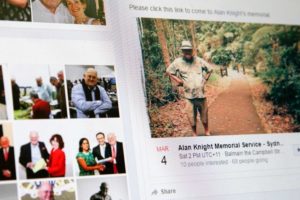
We are all aware of the part social media plays in our lives but it is the growing part it is playing in how we grieve for the dead that caught SheBrisbane’s eye.
A program on ABC Radio National’s Future Tense this week tackled the subject, concluding that grieving on social media was here to stay”.
A report on the program, written by presenter Antony Funnell, is reprinted here:
When the highly regarded media academic Alan Knight died recently, his Facebook page was transformed.
What had been a page of personal anecdotes and reflection became the memorial site for a community — a place where those who knew and loved Knight could share their memories and toast his life.
Such transformations are increasingly common.
“I think we now have to accept that a lot of our grief culture is primarily in the digital space,” says Griffith University sociologist, Margaret Gibson, who has conducted extensive research into the nature of death in the online world.
“No longer the supplementary space for a ritual taking place elsewhere. It is the primary ritual, along with the funeral or the grave and the setting of the gravestone.

“So we have to give it equal value, because it’s here to stay.”
This memorial culture, says Dr Gibson, is challenging traditional societal and cultural constraints around the nature of mourning.
“It’s enabled people to go beyond the constraints of what’s considered to be appropriate mourning at appropriate times and over what period of time,” she says.
“Certainly the Anglo-Saxon person who may feel quite constrained about how long they are able to mourn in front of other people can move beyond rigid timeframes.”
Digital culture is also changing the connection we have with those facing death.
In the last few days of Knight’s life, his friends online were invited to make a final connection before his passing.
Many from across the nation and overseas took up that opportunity. It was a positive and poignant experience.
Communication with the dying was once restricted by geography, time and familial connection, but in the digital world the traditional hierarchies around grief have been disrupted.
Amanda Howell, who studies representations of death in war, says a new level of intimacy has formed.
“We’re getting communication from people we don’t usually get communication from, we’re getting representations that we haven’t gotten before, and we’re getting them with a kind of immediacy that we haven’t gotten before,” she says.
Read the original article here!
SheSociety is a site for the women of Australia to share our stories, our experiences, shared learnings and opportunities to connect.

Leave a Reply